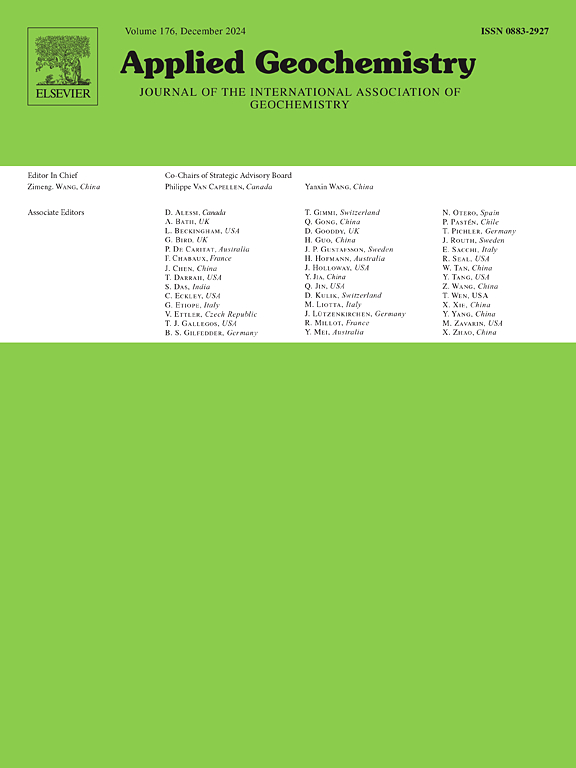Widespread occurrence of amphibole minerals in Paris urban dust samples: a mineralogical tracer of urban wear?
IF 3.4
3区 地球科学
Q1 GEOCHEMISTRY & GEOPHYSICS
引用次数: 0
Abstract
Manufactured infrastructures of urban areas, including buildings and roads, are contributors of solid particles to the environment due to wear processes and further weathering. Mineral dusts produced by such mechanisms are transported by air or water across urban compartments until they accumulate in surrounding natural and artificial sediment reservoirs, mixing with other minerals of geogenic sedimentary origin. With the expansion of artificialized urban surfaces over time, the contribution of urban-sourced minerals is expected to increase in sediment fluxes, thus taking an increasing importance in biogeochemical cycles. In this study, we postulate that mineral particles emitted from specific man-made materials could be traced in different compartments of urban environments on the basis of their mineralogical signature. Such identified urban mineralogical components could then serve as useful markers to monitor urbanization wear processes and subsequent emprise of urbanization at the regional scale. Here, we have analyzed a collection of urban samples, which comprises urban dusts, road sediment deposits, suspended particulate matter from the Seine and Orge rivers near Paris, and sediments accumulating in stormwater basins along high traffic roads in the Paris region (N118, N104). In almost all of the solid samples studied (n = 34), whose sampling span over a ten-year period, we show by powder X-ray diffraction (XRD) the presence of minerals belonging to the amphibole group, which are necessarily derived from human activities since these minerals do not belong to the Parisian sedimentary basin. Detailed analysis of a mineral pellet embedded in bitumen of road treads sampled in a Paris street by analytical electron microscopies and Rietveld refinement analysis of powder XRD pattern show that a ferro-magnesio-actinolite is a major constituent (17 wt%) of this road material. Further analysis of an amphibole grain in a road dust sample by single crystal X-ray diffraction also points to such FeMg-actinolite of Ca2.15Mg2.44Fe2.56Si8O22(OH)2 composition. Other samples collected in the vicinity of areas subjected to road water runoff also contain amphibole minerals of close crystal-chemical composition to this FeMg-actinolite, likely designating road aggregates as sources of amphiboles in our broad set of samples. A large distribution of sizes was observed for amphibole particles using electron microscopy, from massive (100-10 μm) to micrometric packages of elongated mineral particles, likely produced by cleavage of massive particles. The presence of micrometric minerals with elongated fiber habit raises questions about public exposure to such urban dusts. This amphibole signature is also detected in samples of river suspended particulate matter from strongly artificialized urban areas, including in a punctual sample collected in the Seine River, which emphasizes the pervasive occurrence of such minerals in this urban environment. Additionally, the presence of amphibole is suggested by X-ray diffraction on a sample taken on a building roof, which calls for a quantitative investigation of amphibole transport pathways, including air transport, in urban areas. Finally, we propose that this amphibole mineralogical pattern could be used as a mineralogical tracer of city wear and urbanization influence on sedimentary fluxes produced by urban materials.

巴黎城市尘埃样本中广泛存在的角闪孔矿物:城市磨损的矿物学示踪剂?
城市地区的人造基础设施,包括建筑物和道路,由于磨损过程和进一步的风化,是固体颗粒对环境的贡献者。由这种机制产生的矿物粉尘通过空气或水在城市隔间中运输,直到它们在周围的自然和人工沉积物水库中积累,与其他地质沉积起源的矿物混合。随着时间的推移,随着人工城市地表的扩大,城市源矿物对沉积物通量的贡献预计将增加,从而在生物地球化学循环中发挥越来越重要的作用。在这项研究中,我们假设可以根据其矿物学特征在城市环境的不同隔间中追踪特定人造材料释放的矿物颗粒。这样确定的城市矿物学成分可以作为监测城市化磨损过程和随后在区域范围内城市化扩张的有用标志。在这里,我们分析了一组城市样本,其中包括城市尘埃、道路沉积物、巴黎附近塞纳河和乔治河的悬浮颗粒物,以及巴黎地区沿高交通道路的雨水盆地中积累的沉积物(N118, N104)。在几乎所有研究的固体样品中(n = 34),其采样跨度超过十年,我们通过粉末x射线衍射(XRD)显示属于角闪洞组的矿物的存在,这些矿物必然来自人类活动,因为这些矿物不属于巴黎沉积盆地。通过分析电镜和粉末XRD谱图的Rietveld细化分析,对巴黎街道路面路面沥青中嵌入的矿物颗粒进行了详细分析,表明铁镁放线石是该路面材料的主要成分(17 wt%)。通过单晶x射线衍射进一步分析了道路粉尘样品中的角闪孔颗粒,也指出了这种由Ca2.15Mg2.44Fe2.56Si8O22(OH)2组成的femg -放线石。在受道路水径流影响的地区附近收集的其他样品也含有与这种mg -放线石晶体化学成分相近的角闪石矿物,这可能表明我们广泛的样品中道路聚集体是角闪石的来源。电子显微镜观察到角闪孔颗粒的大小分布很大,从块状(100-10 μm)到微米级的细长矿物颗粒,可能是由块状颗粒的解理产生的。具有细长纤维习性的微量矿物质的存在引发了公众接触这种城市粉尘的问题。这种角闪孔特征也在来自高度人工城市地区的河流悬浮颗粒物样本中检测到,包括在塞纳河中收集的准时样本,这强调了这种矿物在城市环境中普遍存在。此外,在建筑物屋顶上采集的样品的x射线衍射表明角闪洞的存在,这需要对城市地区的角闪洞运输途径进行定量调查,包括航空运输。最后,我们提出这种角闪孔矿物模式可以作为城市磨损和城市化对城市物质产生的沉积通量影响的矿物示踪剂。
本文章由计算机程序翻译,如有差异,请以英文原文为准。
求助全文
约1分钟内获得全文
求助全文
来源期刊

Applied Geochemistry
地学-地球化学与地球物理
CiteScore
6.10
自引率
8.80%
发文量
272
审稿时长
65 days
期刊介绍:
Applied Geochemistry is an international journal devoted to publication of original research papers, rapid research communications and selected review papers in geochemistry and urban geochemistry which have some practical application to an aspect of human endeavour, such as the preservation of the environment, health, waste disposal and the search for resources. Papers on applications of inorganic, organic and isotope geochemistry and geochemical processes are therefore welcome provided they meet the main criterion. Spatial and temporal monitoring case studies are only of interest to our international readership if they present new ideas of broad application.
Topics covered include: (1) Environmental geochemistry (including natural and anthropogenic aspects, and protection and remediation strategies); (2) Hydrogeochemistry (surface and groundwater); (3) Medical (urban) geochemistry; (4) The search for energy resources (in particular unconventional oil and gas or emerging metal resources); (5) Energy exploitation (in particular geothermal energy and CCS); (6) Upgrading of energy and mineral resources where there is a direct geochemical application; and (7) Waste disposal, including nuclear waste disposal.
 求助内容:
求助内容: 应助结果提醒方式:
应助结果提醒方式:


